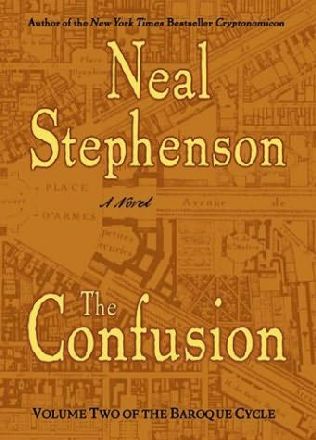Novelistic Alchemy
It was a dubious prospect that I could maintain a book-a-month pace reading something as monstrous as Neal Stephenson’s The Confusion. It took me a good 6-7 weeks to trudge through his previous offering – Quicksilver. But Neal has honed his quill this time, resulting in a more streamlined tale. He’s taken the highlight of Quicksilver – Jack Shaftoe’s exploits, given them a nautical shake, stirred in Eliza’s courtly intrigue – and then con-fused the two tales together.

The very melding Stephenson performs on the meta-elements of his text is the very same that occur through much of the narrative. There are scenes of alchemical melding, rudimentary chemistry (extracting phosphorus from urine), and all the way up the chain of metaphor – the blending of the enlightenment ideals with the medieval world of kings, swordplay, pirates, conquest and treasure.
In the late 1600s, the world is on the brink of modern commerce. The staples of exchange – stamped silver Pieces of Eight – are being replaced with bank notes, lines of credit, stocks, bonds. With it come all the messy realities of that change – international shipping with the threat of piracy, imperialistic powers growing, spreading influence to every corner of the globe.
Jack Shaftoe is at the height of his adventuring powers, escaping from galley slavery with ten fellow slaves. With him are the high points of the book – when his colorful Cabal steals legendary gold from a French Duke, setting off a battle in the streets of Cairo, fleeing through the Red Sea and into the Indian Ocean. They continue on after an extended layover in India, defeating Moghul armies, wooing savage tribal queens, constructing a monumental ship to traverse the vast Pacific. Comparisons to other grand nautical tales (Moby Dick, etc) are apt.
Back in Europe, Eliza has her own close calls, marrying the son of her arch-nemesis, a near-fatal bout of smallpox. The natural philosophers take a back seat to the plotting and money-scheming. Although Waterhouse, Newton and Leibniz are present – they function more as political pawns than brilliant scientists. Eventually Daniel hops a ship Massachusetts bound, not for religious amnesty, but more so to find a quiet cabin at the Massachusetts Institute of Tecknologikal Arts and perfect Leibniz’s calculating machine.
In any case, the book contains a number of brilliant scenes, exchanges, letters, dialogues and twists. Much of the modern world (international commerce, currency, banks, credit) we take as immovable, inevitable, obvious. But there was a time when those foundations were fluid, unfixed, like liquid silver before it has been poured and stamped and given value. Stephenson’s gift – he’s made that history real (sans Enoch Root), and even more so – fun.